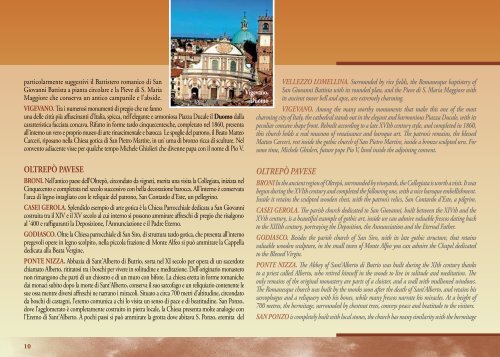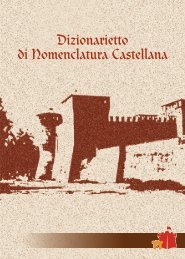luoghi e percorsi tra arte e fede nelle - Provincia di Cremona
luoghi e percorsi tra arte e fede nelle - Provincia di Cremona
luoghi e percorsi tra arte e fede nelle - Provincia di Cremona
You also want an ePaper? Increase the reach of your titles
YUMPU automatically turns print PDFs into web optimized ePapers that Google loves.
particolarmente suggestivi il Battistero romanico <strong>di</strong> San<br />
Giovanni Battista a pianta circolare e la Pieve <strong>di</strong> S. Maria<br />
Maggiore che conserva un antico campanile e l’abside.<br />
viGevano. Tra i numerosi monumenti <strong>di</strong> pregio che ne fanno<br />
una delle città più affascinanti d’Italia, spicca, nell’elegante e armoniosa Piazza Ducale il duomo dalla<br />
caratteristica facciata concava. Rifatto in forme tardo cinquecentesche, completato nel 1860, presenta<br />
all’interno un vero e proprio museo <strong>di</strong> <strong>arte</strong> rinascimentale e barocca Le spoglie del patrono, il Beato Matteo<br />
Carceri, riposano nella Chiesa gotica <strong>di</strong> San Pietro Martire, in un’ urna <strong>di</strong> bronzo ricca <strong>di</strong> sculture. Nel<br />
convento a<strong>di</strong>acente visse per qualche tempo Michele Ghislieri che <strong>di</strong>venne papa con il nome <strong>di</strong> Pio V.<br />
oltrePò Pavese<br />
Broni. Nell’antico paese dell’Oltrepò, circondato da vigneti, merita una visita la Collegiata, iniziata nel<br />
Cinquecento e completata nel secolo successivo con bella decorazione barocca. All’interno è conservata<br />
l’arca <strong>di</strong> legno intagliato con le reliquie del patrono, San Contardo d’Este, un pellegrino.<br />
casei Gerola. Splen<strong>di</strong>do esempio <strong>di</strong> <strong>arte</strong> gotica è la Chiesa Parrocchiale de<strong>di</strong>cata a San Giovanni<br />
costruita <strong>tra</strong> il XIV e il XV secolo al cui interno si possono ammirare affreschi <strong>di</strong> pregio che risalgono<br />
al ‘400 e raffiguranti la Deposizione, l’Annunciazione e il Padre Eterno.<br />
Go<strong>di</strong>asco. Oltre la Chiesa parrocchiale <strong>di</strong> San Siro, <strong>di</strong> struttura tardo gotica, che presenta all’interno<br />
pregevoli opere in legno scolpito, nella piccola frazione <strong>di</strong> Monte Alfeo si può ammirare la Cappella<br />
de<strong>di</strong>cata alla Beata Vergine.<br />
Ponte nizza. Abbazia <strong>di</strong> Sant’Alberto <strong>di</strong> Butrio, sorta nel XI secolo per opera <strong>di</strong> un sacerdote<br />
chiamato Alberto, ritiratosi <strong>tra</strong> i boschi per vivere in solitu<strong>di</strong>ne e me<strong>di</strong>tazione. Dell’originario monastero<br />
non rimangono che parti <strong>di</strong> un chiostro e <strong>di</strong> un muro con bifore. La chiesa eretta in forme romaniche<br />
dai monaci subito dopo la morte <strong>di</strong> Sant’Alberto, conserva il suo sarcofago e un reliquiario contenente le<br />
sue ossa mentre <strong>di</strong>versi affreschi ne narrano i miracoli. Situato a circa 700 metri d’altitu<strong>di</strong>ne, circondato<br />
da boschi <strong>di</strong> castagni, l’eremo comunica a chi lo visita un senso <strong>di</strong> pace e <strong>di</strong> beatitu<strong>di</strong>ne. San Ponzo,<br />
dove l’agglomerato è completamente costruito in pie<strong>tra</strong> locale, la Chiesa presenta molte analogie con<br />
l’Eremo <strong>di</strong> Sant’Alberto. A pochi passi si può ammirare la grotta dove abitava S. Ponzo, eremita del<br />
10<br />
veLLezzo LoMeLLina. Surrounded by rice fields, the Romanesque baptistery of<br />
San Giovanni Battista with its rounded plan, and the Pieve <strong>di</strong> S. Maria Maggiore with<br />
its ancient tower bell and apse, are extremely charming.<br />
viGevano. Among the many worthy monuments that make this one of the most<br />
charming city of Italy, the cathedral stands out in the elegant and harmonious Piazza Ducale, with its<br />
peculiar concave shape front. Rebuilt accor<strong>di</strong>ng to a late XVIth century style, and completed in 1860,<br />
this church holds a real museum of renaissance and baroque art. The patron’s remains, the blessed<br />
Matteo Carceri, rest inside the gothic church of San Pietro Martire, inside a bronze sculpted urn. For<br />
some time, Michele Ghisleri, future pope Pio V, lived inside the adjoining convent.<br />
vigevano,<br />
duomo<br />
oLtrePò Pavese<br />
Broni In the ancient region of Oltrepò, surrounded by vineyards, the Collegiata is worth a visit. It was<br />
begun during the XVIth century and completed the following one, with a nice baroque embellishment.<br />
Inside it retains the sculpted wooden chest, with the patron’s relics, San Contardo d’Este, a pilgrim.<br />
Casei GeroLa. The parish church de<strong>di</strong>cated to San Giovanni, built between the XIVth and the<br />
XVth century, is a beautiful example of gothic art, inside we can admire valuable frescos dating back<br />
to the XIIIth century, por<strong>tra</strong>ying the Deposition, the Annunciation and the Eternal Father.<br />
GoDiasCo. Besides the parish church of San Siro, with its late gothic structure, that retains<br />
valuable wooden sculpture, in the small town of Monte Alfeo you can admire the Chapel de<strong>di</strong>cated<br />
to the Blessed Virgin.<br />
Ponte nizza. The Abbey of Sant’Alberto <strong>di</strong> Butrio was built during the XIth century thanks<br />
to a priest called Alberto, who retired himself in the woods to live in solitude and me<strong>di</strong>tation. The<br />
only remains of the original monastery are parts of a cloister, and a wall with mullioned windows.<br />
The Romanesque church was built by the monks soon after the death of Sant’Alberto, and retains his<br />
sarcophagus and a reliquary with his bones, while many frescos narrate his miracles. At a height of<br />
700 metres, the hermitage, surrounded by chestnut trees, conveys peace and beatitude to the visitors.<br />
san Ponzo is completely built with local stones, the church has many similarity with the hermitage<br />
I LUOGHI DELLA FEDE<br />
the places of faith<br />
periodo romano e non lontano una fonte d’acqua, ritenuta, miracolosa, circondata da boschi <strong>di</strong> castagni<br />
rocca susella. Abbazia romanica <strong>di</strong> San Zaccaria, citata in una bolla <strong>di</strong> Papa Innocenzo III<br />
del 1198, è un monumento <strong>di</strong> grande pregio che merita una visita per quel fondersi <strong>di</strong> toni costituito<br />
dall’alternarsi del mattone e dell’arenaria. L’interno completamente spoglio evidenzia la struttura<br />
originaria.<br />
torricella verzate. Il paese si è sviluppato attorno all’imponente e<strong>di</strong>ficio della Chiesa costruita<br />
alla fine del Settecento in cima ad un’altura. Attorno al sagrato spiccano le cappelle della Via Crucis con<br />
statue in gesso policromo a grandezza naturale che rappresentano gli episo<strong>di</strong> della passione <strong>di</strong> Nostro<br />
Signore. La Scala Santa fu eretta nell’Ottocento; ancora oggi i pellegrini più devoti ne salgono la rampa<br />
me<strong>di</strong>ana in ginocchio perché i suoi gra<strong>di</strong>ni posano su un terreno proveniente dalla Palestina.<br />
varzi. Antico borgo me<strong>di</strong>evale nel cuore della Valle Staffora presenta una storia che si intreccia con<br />
quella dei Malaspina, come testimoniano i numerosi castelli della zona. L’ascesa economica e sociale <strong>di</strong> Varzi<br />
raggiunse il culmine dopo il XII secolo, quando <strong>di</strong>venne un importante centro <strong>di</strong> <strong>tra</strong>nsito delle merci da<br />
e per Genova lungo la cosiddetta “Via dei Feu<strong>di</strong> Imperiali” o “ Via del Sale”. Merita una visita la Pieve dei<br />
Cappuccini, in stile romanico, con la caratteristica facciata in arenaria nella p<strong>arte</strong> inferiore e sovrastata da<br />
un bellissimo cotto a vista. La Chiesa parrocchiale <strong>di</strong> San Germano, e<strong>di</strong>ficata nel 1580, sorge nel centro<br />
<strong>di</strong> Varzi e fronteggia la torre Soprana che, insieme alla torre Sottana, rappresenta i resti <strong>di</strong> antiche mura.<br />
varzi – cella. Tempio della Fraternità dei Popoli, e<strong>di</strong>ficato nel 1951 sui resti <strong>di</strong> un’antica chiesa<br />
risalente al XV secolo, dal punto <strong>di</strong> vista architettonico si allontana dai canoni <strong>tra</strong><strong>di</strong>zionali. Al suo interno,<br />
per iniziativa <strong>di</strong> Don Adamo Accossa, una serie <strong>di</strong> cimeli provenienti dai campi <strong>di</strong> battaglia della seconda<br />
guerra mon<strong>di</strong>ale contribuiscono ad arredare questa originale ed unica chiesa de<strong>di</strong>cata agli ideali <strong>di</strong> pace.<br />
Le campane sono fuse con il bronzo ricavato da materiale bellico, mentre l’altare, il pavimento, il pulpito<br />
e la fonte battesimale sono composti da resti <strong>di</strong> altre chiese bombardate e da relitti <strong>di</strong> navi e cannoni.<br />
voGhera. Il Duomo de<strong>di</strong>cato a San Lorenzo e rifatto nel Seicento conserva al suo interno un affresco<br />
del 1496 raffigurante la Madonna del Soccorso, considerata <strong>di</strong>spensatrice <strong>di</strong> grazie. Nel 986 qui morì<br />
San Bovo, santo guerriero che aveva sconfitto i feroci saraceni invasori della Francia. Per ringraziare il<br />
Cielo della vittoria concessagli, si stava recando in pellegrinaggio a Roma ma la morte lo colse durante<br />
il cammino. Divenne patrono della città e in suo onore venne costruito un ospizio a lui de<strong>di</strong>cato.<br />
of Sant’Alberto. A few steps away you can visit the cave where lived S. Ponzio, roman hermit, and the<br />
spring, believed to be miraculous, surrounded by chestnut trees.<br />
roCCa suseLLa. The Romanesque Abbey of San Zaccaria, mentioned in a bull of Pope Innocenzo<br />
III in 1198, is a relevant monument that deserves to be seen for the alternation of colours between the<br />
brick and the sandstone. The interior is completely bare and highlights the original structure.<br />
torriCeLLa verzate. The town developed around the overbearing buil<strong>di</strong>ng of the church<br />
that was built at the end of the XVIIIth century, on the top of a hill. Around the parvis stand out the<br />
chapels of the Via Crucis with life sized polychrome plaster statues depicting the episode of the Passion<br />
of Christ. The Holy Stairs was built during the XVIIIth century, today still the most devoted pilgrims<br />
go up the middle flight on their knees, because its steps stand on ground coming from the Palestine.<br />
varzi. The story of the ancient me<strong>di</strong>eval village in the middle of Valle Staffora is linked to the<br />
Malaspina family, as many local castles can testify. The economical and social rise of Varzi reached<br />
its peak after the XIIth century, when it became a crucial logistic point for goods to and from Genoa,<br />
along the so called “Via dei Feu<strong>di</strong> Imperiali” (Road of Imperial Feuds) or “Via Salaria” (Salt Road).<br />
The Romanesque Pieve dei Cappuccini is worth a visit, with its peculiar front with sandstone at the<br />
lower part and towered by beautiful earthenware. The parish church of San Germano was built in<br />
1580, and stands in the middle of Varzi, facing Tower Soprana that, together with tower Sottana,<br />
was part of the ancient walls.<br />
varzi – CeLLa. Built in 1951 on the ruins of an old XVth century church, the Tempio della<br />
fraternità dei popoli is far from the <strong>tra</strong><strong>di</strong>tional architecture. Inside, the great number of relics from<br />
WWII, collected by Don Adamo Accossa, furnishes this original and unique church de<strong>di</strong>cated to<br />
peace. The bronze bells are made with melted weapons, while the altar, the floor, the pulpit, and the<br />
baptismal font come from other churches ruined by bombs and from wrecked ships and cannons.<br />
voGhera. The Cathedral of San Lorenzo was rebuilt during the XVIIth century, here we can find<br />
a 1496 fresco depicting a Madonna del Soccorso, believed to grant mercy. Here, in 986, <strong>di</strong>ed San<br />
Bovo, a warrior saint that beat the Saracens inva<strong>di</strong>ng France. To thank God for his victory he was<br />
going to Rome for pilgrimage, but he <strong>di</strong>ed while <strong>tra</strong>velling. He became patron of the town and they<br />
de<strong>di</strong>cated him a hospital.<br />
11



